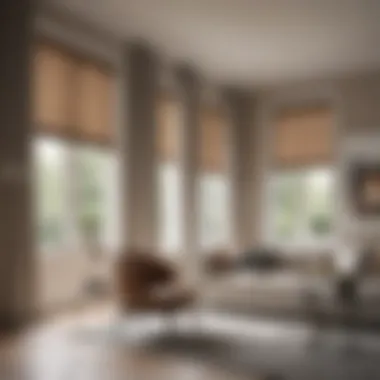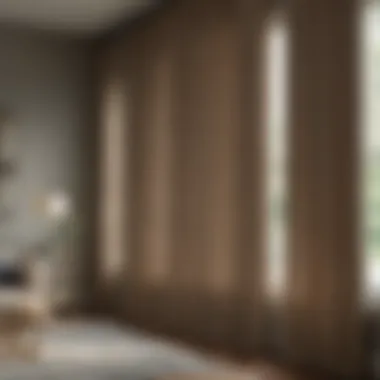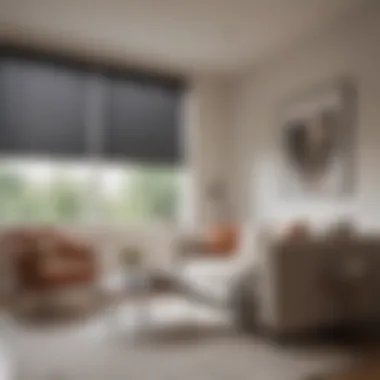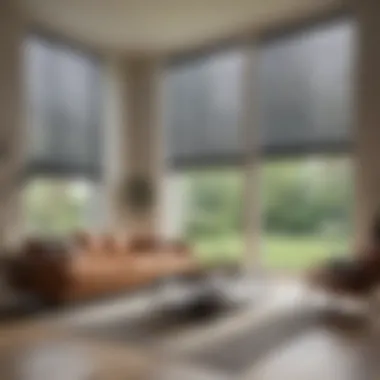Choosing the Perfect Blinds for Full Length Windows


Intro
When it comes to full-length windows, they deserve more than just any old window treatment. Selecting the right blinds can make or break the aesthetic of a room, not to mention its functionality. Whether you’re a homeowner looking to enhance your living space or a designer planning a stunning interior, understanding the nuances of blinds selection is crucial. In this guide, we’ll take you through various factors to consider, from styles and materials to the practicalities of installation and maintenance. Together, we’ll explore how to harmonize functionality with elegance, ensuring that those expansive windows don’t just serve a purpose, but also dazzle.
Furniture Trends
As styles shift, so do the trends in window treatments. Full-length windows are increasingly viewed not just for views, but as an integral part of home design. Here are some key points to consider when choosing blinds in today’s market.
Current Market Trends
In the current landscape, minimalism stands tall. Many homeowners are leaning towards clean lines and subtle palettes. Natural materials like wood and bamboo have gained popularity, appealing to an eco-conscious audience. Fabrics such as sheer linen provide an airy feel, allowing natural light to filter through while maintaining a touch of elegance.
Homeowners today are also opting for customization. Made-to-measure blinds cater to unique spaces, ensuring a perfect fit. This trend of getting blinds tailored can elevate the overall aesthetic significantly. Automation is another game changer. Blinds that can be controlled via smartphone apps or voice commands are making life more convenient than ever.
Popular Styles and Designs
You’ll find a wide variety of styles that can complement full-length windows. Some of the top contenders include:
- Roller Blinds: Sleek and versatile, these are available in numerous colors and patterns. They're particularly favored for their simplicity and ease of use.
- Vertical Blinds: Ideal for large windows, they offer excellent light control and can slide easily to one side.
- Roman Shades: These add a touch of sophistication. When drawn, they fold neatly, creating a soft, inviting look.
- Panel Track Blinds: Perfect for modern spaces, they glide along a track and are made for larger openings, providing a contemporary feel.
When choosing a style, consider the overall design of the room. For instance, matching the fabric of the blinds with upholstery or drapery can create a cohesive look that impresses.
"Blinds are not just functional; they’re a silent steward of style in any room."
In summary, selecting the right blinds for full-length windows involves understanding current trends and popular styles that resonate with your tastes and enhance your space's character. Let’s dive deeper into practical aspects, making it easier to navigate the selection process.
Understanding Full Length Windows and Their Unique Needs
When it comes to creating a serene and inviting space, full length windows play a significant role. Their expansive glass panes allow for a remarkable influx of light, but they also bring unique needs that homeowners must address. This section dives into those intricacies, aiming to equip you with a deeper understanding of your needs when selecting blinds for large windows.
Defining Full Length Windows
Full length windows are typically defined as windows that stretch from floor to ceiling, or those that reach close to it. They can be traditional windows or modern designs, often serving as stunning focal points in a room. Their sheer size not only gives a sense of openness, but they also change how people perceive the space they inhabit. In homes with full length windows, beauty often lies in their ability to connect the indoor and outdoor realms, making a home feel expansive and airy.
Challenges of Covering Large Window Spaces
The challenges associated with covering large window spaces are numerous. One of the most pressing is the practical aspect of size. Standard blinds often don’t fit the vast expanse, leading to the challenge of finding larger blinds that can provide adequate coverage and functionality. Additionally, the weight of the blinds becomes an important consideration. Heavy materials can strain hardware, requiring more robust installations.
Furthermore, there is the issue of visibility. Owners might grapple with how to maintain their view while ensuring privacy and light control. Selecting the right style can mean the difference between a welcoming atmosphere and dealing with glaring sunlight. There’s also the potential for heat loss or gain; effectively insulating large windows with blinds can be quite complex.
Importance of Natural Light Control
Natural light control is pivotal when dealing with full length windows. The amount of light entering a room can significantly impact the mood and energy inside. Too much radiant sun can lead to faded furniture or an overbearing heat in the summer months, while too little light can make a space feel constricted or damp.
Properly selected blinds can enhance natural light management, allowing homeowners to
- Regulate brightness: Blinds can be adjusted to filter or block light as needed, creating the perfect ambiance at any time of the day.
- Prevent UV damage: High-quality blinds will protect your interiors from harmful ultraviolet rays, ensuring longevity for fabrics and textures.
- Support energy efficiency: By regulating the temperature inside a home, homeowners can potentially lower their energy bills.
"Choosing the right blinds for full length windows isn’t just about aesthetics; it's about enhancing your home's functionality and comfort."
Understanding these unique requirements can significantly help homeowners, renters, and designers make informed decisions about blinds that elevate their living spaces while addressing practical needs.
Types of Blinds Available for Full Length Windows
When it comes to dressing full-length windows, selecting the right type of blinds is crucial. The right choice can enhance the aesthetics of your room, while providing the necessary function of light control and privacy. With numerous options available, each type of blind comes with its unique features and benefits. By understanding these variants, you can make a more informed choice that aligns with your personal style and practical needs.
Vertical Blinds
Vertical blinds stand out as a practical choice for large windows. Made of slats that hang vertically, they are especially useful for wider windows or sliding glass doors. One of the key benefits of vertical blinds is that they can be easily adjusted to control the amount of light entering your space.
They also offer a sense of openness. When drawn back, they allow unobstructed views outside, making your space feel larger. It's easy to clean them too, just a simple wipe down and they look new again. However, keep in mind that they may not suit every decor style. Their utilitarian look works best in contemporary spaces but might not be the best match for a more traditional ambience.
Roller Blinds
Roller blinds are another solid option for full-length windows. As the name suggests, these blinds roll up and down, allowing for quick adjustments on light and privacy. They come in a vast array of fabrics, colors, and patterns which means customization is endless.
For those who value a clean and minimalist look, roller blinds can blend seamlessly into your decor. They’re also fairly straightforward to operate and maintain. On the downside, if you prefer a more textured or layered look, roller blinds might fall short, as they have a more flat appearance.
Roman Blinds
Roman blinds offer a touch of elegance and softness to any room. Made from fabric that folds neatly when raised, they add both texture and style. This style is ideal for creating a warm atmosphere in living rooms or bedrooms. Additionally, they can be lined for better insulation and light control, enhancing their energy efficiency.
However, it is worth noting that roman blinds require a bit more upkeep; fabric can gather dust and dirt, necessitating regular cleaning. Selecting the right fabric can make all the difference; lighter fabrics provide a subtle look, while heavier ones cater to a more luxurious vibe.


Panel Track Blinds
If you're looking for a modern solution for a large wall of windows, panel track blinds might be what you need. They consist of wide fabric panels that slide along a track, making them a smart choice for keeping a large window area uncluttered. These blinds can be drawn to one side or split down the center for versatile light control.
The bonus of panel track blinds is their ability to work as room dividers as well, offering flexibility beyond just window treatment. Keep in mind, however, they might not fit universally with all interior themes; they align best with contemporary aesthetics.
Sheer Blinds
For those seeking a balance between light and privacy, sheer blinds provide an innovative solution. These are designed with a combination of sheer fabric that gently filters light while still maintaining a certain level of visibility. Sheer blinds can add a layer of sophistication to your windows while allowing natural light to flow through.
They are particularly popular in sunrooms or living spaces where soft lighting is desired. However, if privacy is a major concern during nighttime, sheer blinds without an additional layer could leave your space exposed.
Each type of blind offers distinct advantages and limitations, which means recognizing your personal needs and style can lead you to the best choice for your full-length windows. Choosing wisely here not only enhances your home’s functionality but also its aesthetic appeal.
"The perfect set of blinds can transform a room from mundane to magnificent."
With the right information in hand, you can confidently make a choice that suits both your taste and practical requirements for those grand window spaces.
Material Considerations When Choosing Blinds
Choosing the right material for blinds is an essential step when dealing with full-length windows. Large windows typically invite a greater influx of light and can significantly affect the ambiance of a room. Thus, understanding the strengths and weaknesses of various blind materials not only helps in function but also elevates the overall aesthetic appeal of your space.
Material plays a vital role in longevity, ease of maintenance, light control, and, of course, the look you want to achieve in your room. Each material has its distinct characteristics that can complement certain styles of decor, making it imperative to evaluate carefully before making a choice.
In this section, we will explore the three primary categories of materials used for blinds: fabrics, wood and faux wood, and metals like aluminum and vinyl. Each option provides different benefits and comes with its own set of considerations you must keep in mind.
Fabric Options
When thinking about fabric options, versatility comes to mind. Fabric blinds can lend a softness to a room that hard materials simply can't match. They can easily absorb sound, making spaces feel more intimate, while also offering various shades, textures, and patterns.
Common choices include:
- Cotton: Great for a relaxed look, easily washable, but may fade a bit in bright sunlight.
- Polyester: Durable and stain-resistant; it’s also less prone to wrinkling.
- Light-filtering Fabrics: These offer some level of privacy while allowing diffused light to soften the glow in a room.
- Blackout Fabrics: Ideal for bedrooms or media rooms where total darkness is preferred.
While selecting fabric blinds, consider not just the aesthetic but also the care involved. Certain fabrics may require special cleaning methods, which can influence how you use your space.
Wood and Faux Wood Blinds
Wood has been a mainstay in window treatments due to its timeless appeal and natural insulation properties. If you want to evoke a sense of warmth and elegance, genuine wood blinds can be the perfect choice. They carry a somewhat higher price tag, but the aesthetic value often justifies it.
Faux wood, however, is increasingly popular. Made from composite materials, they mimic the look of real wood but come with additional benefits such as:
- Moisture Resistance: It holds up much better in humid areas like bathrooms or kitchens.
- Cost-effective: Generally, faux wood is lighter on the wallet yet can deliver a similar look.
- Ease of Maintenance: Typically, a simple wipe with a damp cloth does the trick.
For anyone considering the classic charm of wooden blinds but wary about their durability, faux wood offers a practical compromise.
Aluminum and Vinyl Choices
When it comes to practicality, aluminum and vinyl are hard to overlook. These materials are often favored for their durability and low maintenance needs. They resist fading, chipping, and scratching, making them excellent choices for high-traffic homes or public spaces.
Some key points to ponder:
- Aluminum Blinds: Known for their sleek, modern look, they are lightweight and come in a variety of finishes, adding a contemporary touch. However, they can dent if not handled carefully.
- Vinyl Blinds: Usually cheaper than both wood and aluminum, vinyl is especially popular in areas with children or pets. They resist moisture and are easy to clean, making them ideal for kitchens and bathrooms.
Both aluminum and vinyl blinds can help maintain energy efficiency by reflecting heat away from the windows, which might be a boon for homeowners looking to cut back on energy bills.
"Choosing the right material for blinds not only enhances aesthetic but also affects functionality, often determining how comfortable and inviting a space feels."
In summary, understanding the varying material options available can profoundly influence your decision-making process. When choosing, don’t just think about how they will look, but also consider how they will perform over time. Delve into each category, weigh the pros and cons, and remember to align your choices with your personal style and practical needs.
Aesthetic Considerations for Blinds
When selecting blinds for full-length windows, aesthetics play a pivotal role that should not be brushed aside. The right choice can elevate a room from ordinary to extraordinary, reflecting personal style while providing essential functionality. Given the significant surface area of full-length windows, the visual impact of blinds extends beyond mere window treatments; they can actually alter the character of a space. Homeowners and designers alike must give due consideration to how the blinds harmonize within the broader design scheme.
Color and Pattern Selection
In the realm of interior design, color is more than just a visual cue; it's an emotional trigger. When choosing blinds, one must consider both the color and patterns that resonate with the existing decor. Opting for colors that either complement or contrast with wall paints and furnishings can create an engaging visual dialogue. For instance, light pastels can imbue a space with softness and tranquility, while bold colors like deep blues or fiery reds can make a striking statement.
Patterns can also serve a dual purpose—functionally helping to mask wear and tear while simultaneously adding character to a room. Think about floral prints for a bohemian aesthetic, or sleek, geometric designs for something more modern. However, it's crucial to strike the right balance; a busy pattern could overwhelm a small space, whereas overly simplistic designs could make an expansive room feel cold and unwelcoming.
Matching with Interior Decor
To ensure that the blinds seamlessly integrate with interior decor, a thoughtful approach is necessary. Look at the overall theme of the room: is it rustic, contemporary, or perhaps traditional? In a room filled with natural wood elements, wooden or faux wood blinds might enhance that organic feel. Alternatively, a modern space with sleek furniture may benefit from roller blinds in chic colors or minimalist fabric.


Moreover, the texture of the blinds should not be overlooked. Combining textures can add depth; a soft linen blind might work beautifully against a leather armchair or a smooth metal lamp. Ultimately, the goal is to ensure that the blinds do not stand as an afterthought, but rather feel like an intentional part of the overall expression of the space.
Creating Visual Harmony
Creating visual harmony involves finding a balance between all elements in the room, including lighting, furniture, and accessories. One effective way to achieve this is by repeating colors and styles from other elements throughout the space. For example, if your dining chairs have a certain hue, incorporating that same color in your blinds can unify the design.
Moreover, consider the play of light and shadow. Full-length windows naturally play a huge role here, and the way a blind interacts with these elements can amplify or dampen the ambiance of the room. Natural light can enhance textures, colors, and patterns when filtered properly, making the choice of blinds pivotal in creating a cozy atmosphere.
"The aesthetics of window treatments transcend mere functionality; they form a visual bridge between the inside world of your home and the outside landscapes."
Ultimately, selecting blinds that consider aesthetic factors is about enhancing one’s lifestyle and personal preferences. By investing time and thought into color selection, matching decor, and achieving harmony, homeowners can transform their living spaces into cohesive, inviting retreats.
Functional Factors to Consider
When it comes to selecting blinds for full-length windows, functionality takes center stage. It’s not just about finding something that looks pretty; the practical aspects matter a great deal, too. Homeowners and designers alike need to weigh a few critical factors, such as light control, privacy levels, and energy efficiency. Each of these factors plays a distinct role in how comfortable and satisfied one can be with their choice. Understanding these elements is crucial in crafting a harmonious living environment, especially when the stakes of investment and style are high.
Light Control
Managing light effectively transforms a space. Full-length windows flood a room with natural light, which is wonderful for brightening up spaces during the day but can lead to overheating and glare if not controlled properly. Blinds come in a variety of styles specifically designed to manage light levels.
- Adjustable Options: Vertical blinds and sheer varieties allow for easy adjustment, enabling you to fine-tune the angle of light according to your preferences.
- Blackout Features: In cases where a dark environment is necessary, especially in bedrooms, blackout roller blinds can work wonders. They block out practically all light, ensuring a cozy atmosphere for sleep or movie nights.
A well-considered choice in blinds can create ambiances that shift with the time of day, allowing homeowners to make the most out of their spaces while also conserving privacy.
Privacy Levels
Privacy is a significant concern, individual to every home. Full-length windows, while visually appealing, can come with the challenge of overlooking neighbors or busy streets. Choices in blinds can help here, too.
- Light Filtering Options: Sheer blinds, for instance, can provide an ideal balance, allowing light in while obscuring the view from outside. This is particularly useful in living areas where you may not want an entirely closed-off feeling but still seek privacy.
- Stronger Solutions: On the other hand, heavier fabric blinds or even wooden options might offer added privacy, especially during nighttime hours when lights from inside spill out into the darkness outside.
Homeowners often find themselves needing a compromise between illumination and concealment, thus compelling them to choose thoughtfully among the vast array of options.
Energy Efficiency
In today’s world, energy efficiency isn’t just a buzzword; it’s a crucial criterion in selecting any product for the home, blinds included. The right blinds can help reduce energy consumption while keeping rooms comfortable year-round.
- Insulating Features: Certain materials, like honeycomb shades, are designed to trap air, offering insulation that keeps the hot air out in summer and retains warmth during winters. This can lead to reduced reliance on heating and cooling, ultimately cutting down on utility bills.
- Reflective Choices: Blinds made with reflective materials can also help redirect sunlight, preventing overheating and reducing the need for air conditioning during scorching months.
Thus, selecting the right blinds can be not merely an aesthetic decision but a strategic approach to managing energy use effectively.
"Choosing the right blinds can transform a room’s atmosphere by balancing light, privacy, and energy efficiency. It’s more than style; it’s about creating a comfortable, functional living space."
Operational Methods for Blinds
Selecting the right operational method for your blinds can completely transform how you interact with your full-length windows. This aspect isn't merely about choosing a system at random; it plays a pivotal role in the overall functionality and user experience of your window treatments.
Understanding the operational methods can help you tailor your choice based on your practical needs—be it simplifying your daily routine, enhancing safety, or simply elevating the aesthetic appeal of your space. Choosing between manual and motorized systems is essential because it can affect everything from light control to ease of accessibility.
Manual vs. Motorized Systems
The debate between manual and motorized blind systems isn't just about convenience; it reflects personal taste and lifestyle choices.
- Manual Systems: These are often viewed as the classic choice. Manual operation tends to offer simplicity. With a simple pull of a cord or adjustment of a wand, you have immediate control over the light entering your room. They can serve as an elegant, low-tech option that fits into various design themes. Plus, they usually come at a lower cost, making them budget-friendly. However, they can be less ideal for hard-to-reach areas or larger windows.
- Motorized Systems: On the flip side, motorized blinds have become quite popular, and for good reason. They provide ultimate convenience, especially in homes with expansive window areas. With just a press of a button or a simple voice command linked to your smart home system, you can adjust your blinds from the comfort of your couch. They can also be programmed for specific times or controlled remotely. However, it's important to note that they often come with a hefty price tag and may require more maintenance due to electrical components.
Choosing between these systems often comes down to personal preference combined with practicality.
Ease of Use Considerations
When determining the best operational method, ease of use should never be overlooked.
With multiple options on the market, consider how often you will adjust the blinds, your physical capabilities, and the overall design of your living space.
- Accessibility: If you have high or hard-to-reach windows, motorized blinds can serve you well. It’s all about eliminating the hassle—having to climb a stepladder isn’t the best way to enjoy your morning light!
- User-Friendliness: Think of your daily routine. If you prefer a quick adjustment, motorized options can offer that instant gratification with minimal effort. Manual systems might be great for some, but really assess if they would fit seamlessly into your lifestyle.
- Control Options: Many motorized blinds can integrate with home automation devices. This means you can adjust settings right from your smartphone or through voice-activated systems. In contrast, manual blinds may require you to be present physically at the window for adjustments.
Ultimately, the choice between manual and motorized systems should echo your lifestyle and the specific needs of your living space. A thorough assessment of each option helps you strike the right balance between ease of operation and functionality, paving the way for a more enjoyable home environment.
"The way you operate your blinds can either streamline your daily tasks or complicate them further. Choose wisely."
Maintenance and Care of Blinds
When it comes to maintaining the aesthetic charm and functionality of blinds for full-length windows, care is crucial. Proper maintenance not only prolongs the life of your window treatments but also ensures they continue to serve their purpose effectively. This section dives into the essential elements of upkeep, highlighting why diligence in care can save you from costly replacements down the line.
Cleaning Different Materials


The materials of your blinds dictate the cleaning methods to use and the frequency with which you should do so. Each type presents its unique challenges and advantages:
- Fabric Blinds: Regular dusting with a soft cloth or a vacuum with a brush attachment is vital. In cases of stubborn stains, using a mild detergent mixed with water can do wonders. Just be careful not to soak the fabric; a light touch is key.
- Wood and Faux Wood Blinds: A simple wipe-down with a damp cloth works best for these materials. It’s important to avoid excess water to prevent warping or damage. For faux wood, a mixture of vinegar and water can help to break down grime without risking harm.
- Aluminum Blinds: These are pretty low-maintenance. A damp cloth or sponge combined with a gentle cleaner usually gets the job done. Ensure you rinse them well afterward to prevent streaks or residue.
- Vinyl Blinds: A quick wipe with a damp cloth suffices, but for deeper cleaning, they can be fully immersed in soapy water and rinsed, just ensuring they dry properly to avoid any mold issue.
Regular cleaning isn't just about looks; it’s about hygiene, too. Dust, allergens, and grime don't just sit idly. They can affect air quality, especially in homes with allergies or respiratory concerns.
Longevity and Care Tips
Focusing on longevity isn’t just about cleaning; understanding how to care for the blinds can dramatically increase their lifespan. Here are some tips that are often overlooked:
- Avoid Direct Sun Exposure: While full-length windows invite beautiful light, excessive direct sunlight can fade and weaken materials over time. Consider using UV filters or pairing your blinds with sheer curtains.
- Gentle Handling: Always raise or lower blinds carefully. Rough handling can lead to tangled cords or bent slats, ultimately compromising functionality.
- Regular Inspections: Make it a habit to check for any signs of wear and tear. This includes frayed cords, bending slats, or any discoloration. Catching these early can save you from having to replace entire blinds later.
- Professional Cleaning: For some materials, like delicate fabrics or complex mechanisms, professional cleaning might be worth the investment. Not only can it keep the blinds in peak condition, but it can also save precious time.
"A little maintenance goes a long way in preserving the beauty and functionality of your blinds, ensuring they serve you well for years to come."
By keeping these tips in mind, you're not just caring for your blinds; you're making a statement about your living space. A well-maintained environment speaks volumes about attention to detail and overall home aesthetics.
Budgeting for Full Length Window Blinds
When it comes to selecting blinds for full-length windows, budgeting plays a pivotal role. Not only does it determine what options are available, but it also influences the quality, design, and longevity of the window treatments. This section examines why budgeting is essential for homeowners, renters, designers, and even retailers.
Allocating a budget lets you establish a baseline for your choices. Without a financial framework, it’s easy to get lost in the myriad of options. You start gravitating towards high-end materials and intricate designs, which can lead to overspending. Therefore, having a clear budget helps in narrowing down selections while still achieving the desired aesthetic and functionality.
Moreover, being mindful of budgeting fosters thoughtful decision-making. It nudges you to consider the total cost of ownership, which includes initial purchase price as well as ongoing maintenance and operational costs. Focusing solely on the sticker price often results in regret down the road.
In addition, different types of blinds come with their price tags. Understanding these cost variations allows you to get the biggest bang for your buck. Now let’s dive into the specifics of costs based on the different types of blinds available.
Cost Variations Across Types
Each type of blind brings its own set of costs. For instance, vertical blinds are often more affordable compared to custom-made Roman blinds, which can be quite steep. It’s essential to weigh functionality against your budget. Below are some examples to consider when looking at types of blinds:
- Vertical Blinds:
- Roller Blinds:
- Roman Blinds:
- Panel Track Blinds:
- Sheer Blinds:
- Generally starting from lower price points.
- Simple design makes them easier to manufacture.
- Cost-effective and easy to clean.
- Usually available in a vast array of colors and fabrics, which can affect price.
- Tend to be more expensive due to their fabric and custom design element.
- Often seen as a luxurious option, impacting overall spend.
- Custom-made solutions can elevate price significantly.
- Great for large window spaces, yet their cost needs consideration.
- Prices vary based on fabric and layered design.
- Known for their light-diffusing properties, ideal for enhancing natural light while providing some privacy.
Takeaway: Knowing that each type carries its own average cost spectrum can help guide your selection effectively. This helps avoid overspending while still getting the look you envision.
Value vs. Price
When discussing blinds, it’s crucial to differentiate between value and price. Price is straightforward; it's the amount you pay. Value, however, encompasses the benefits derived from the purchase. Investing in high-quality materials often comes with a higher price tag, but the longevity and aesthetics of premium options frequently justify the expense.
For example:
- Aluminum Blinds may cost less upfront but could require frequent replacement or maintenance.
- Faux Wood Blinds, while pricier initially, can add a level of value through their durability and style. They resist moisture and won’t warp, unlike regular wood blinds, making them a smart monetary choice over time.
While pursuing elegance and functionality, also assess your lifestyle needs. A busy household might benefit from easy-to-maintain materials rather than high-end fabric that shows wear and tear quickly.
At the end of the day, the goal should be to strike a balance where the money spent brings you satisfaction and meets your needs long-term. Budgeting isn’t merely about restrictions; it’s about making informed choices that pay dividends in both style and practicality.
The End: Finding the Right Blend
When it comes to selecting blinds for full-length windows, finding the right balance between aesthetics and practicality is crucial. This section encapsulates the essential elements discussed throughout the article and highlights the relevance of making informed decisions.
A well-thought-out choice in blinds can enhance the overall ambiance of a room while fulfilling functional needs. This is not just about blocking light or ensuring privacy; it’s about harmonizing the style of your home with its practical demands. By recognizing that blinds serve dual purposes, homeowners and designers alike can create spaces that are both inviting and functional.
Creating a Balanced Space
Creating a balanced space involves considering the interplay between your blinds and the other elements in the room. Here are several factors to consider:
- Color Coordination: The color of your blinds should complement the color palette of your walls, furniture, and decor. Whether you lean towards neutral tones or prefer bold colors, ensure they work together.
- Texture and Material: Mixing textures can add depth to a room. A smooth roller blind might pair well with a plush sofa, while wooden blinds can soften the harsh lines of modern furniture. Choosing materials that resonate with the room's theme, whether modern, rustic, or eclectic, is significant.
- Light Behavior: Consider how light interacts with the room. Blinds that allow filtered light can create warmth and make your space feel more open. On the other hand, blackout blinds are perfect for bedrooms, ensuring privacy and restful sleep.
Establishing this balance isn't a one-size-fits-all task. Each choice should reflect your personal style while enhancing the functionality of your living environment.
Future Trends in Window Treatments
As we look to the future, several trends in window treatments are emerging that could influence the way we select blinds for full-length windows.
- Sustainable Materials: There is an increasing need for eco-friendly options. Blinds made from recycled materials or sustainable sources are becoming more popular. This shift is not just environmentally conscious but also appeals to the modern consumer's preference for sustainable living.
- Smart Technology: Motorized blinds are gaining traction, offering convenience and advanced features. Imagine controlling your blinds with a simple voice command or through an app, allowing you to set moods with ease. This technology is particularly appealing for hard-to-reach windows, adding a layer of modern convenience.
- Custom Designs: Personalization is key. Many homeowners are looking for unique design options that reflect their taste. This trend caters to creative expression in home decor, allowing individuals to select patterns, colors, and materials that speak to their personal style.
"A well-planned approach to window treatments can elevate your space, ensuring it feels complete and sophisticated."
By integrating these insights, you can achieve the balance of beauty and utility in your window treatment choices.















